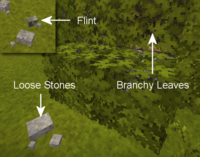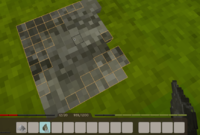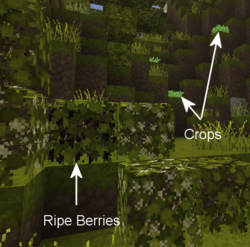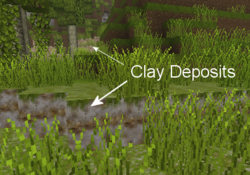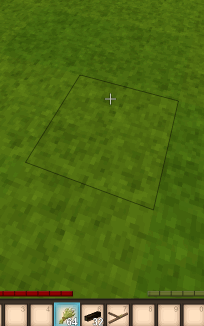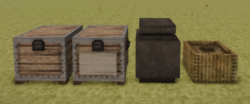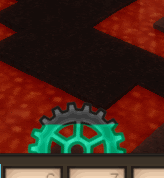Survival Guide - Your first day/zh: Difference between revisions
(Created page with "<div style="float:left; margin-right:20px;"> === 角色 === {| |- | <span class="key"><span>W</span></span> <span class="key"><span>A</span></span> <span class="key"><span>S</span></span> <span class="key"><span>D</span></span> || 四处移动 |- | <span class="key" id="key-spacebar"><span>Space</span></span> || 跳跃 |- | <span class="key"><span>E</span></span> || 背包物品栏(打开制作网格) |- | <span class="key"><span>C</span></span> || 角色物品栏(...") |
(Created page with "=== 用户界面 === {| |- | <span class="key" id="tab"><span>tab</span></span> || 打开/隐藏 聊天栏 |- | <span class="key"><span>T</span></span> || 直接聊天栏输入 |- | <span class="key key-fn"><span>F4</span></span> || 显示/隐藏用户界面 |- | <span class="key key-fn"><span>F6</span></span> || 显示/隐藏小地图 |- | <span class="key"><span>B</span></span> || 显示/隐藏方块信息 |- | <span class="key"><span>H</span></span> || 生成手册 -...") |
||
| Line 32: | Line 32: | ||
<div style="float:left;"> | <div style="float:left;"> | ||
=== | === 用户界面 === | ||
{| | {| | ||
|- | |- | ||
| <span class="key" id="tab"><span>tab</span></span> || | | <span class="key" id="tab"><span>tab</span></span> || 打开/隐藏 聊天栏 | ||
|- | |- | ||
| <span class="key"><span>T</span></span> || | | <span class="key"><span>T</span></span> || 直接聊天栏输入 | ||
|- | |- | ||
| <span class="key key-fn"><span>F4</span></span> || | | <span class="key key-fn"><span>F4</span></span> || 显示/隐藏用户界面 | ||
|- | |- | ||
| <span class="key key-fn"><span>F6</span></span> || | | <span class="key key-fn"><span>F6</span></span> || 显示/隐藏小地图 | ||
|- | |- | ||
| <span class="key"><span>B</span></span> || | | <span class="key"><span>B</span></span> || 显示/隐藏方块信息 | ||
|- | |- | ||
| <span class="key"><span>H</span></span> || | | <span class="key"><span>H</span></span> || 生成手册 - 也可以在将鼠标指针悬停在物品栏中的物品上时使用 | ||
|- | |- | ||
| <span class="key shiftleft"><span>SHIFT</span></span> + <span class="key"><span>H</span></span> || | | <span class="key shiftleft"><span>SHIFT</span></span> + <span class="key"><span>H</span></span> || 查看世界中方块或物品的生存手册内容 | ||
|- | |- | ||
| <span class="key"><span>M</span></span> || | | <span class="key"><span>M</span></span> || 显示/隐藏 [[worldmap|世界地图]] | ||
|- | |- | ||
| <span class="key"><span>N</span></span> || | | <span class="key"><span>N</span></span> || 显示/隐藏方块交互帮助 | ||
|- | |- | ||
| <span class="key"><span>V</span></span> || | | <span class="key"><span>V</span></span> || 显示/隐藏坐标 | ||
|- | |- | ||
| <span class="key key-fn"><span>F12</span></span> || | | <span class="key key-fn"><span>F12</span></span> || 截图 | ||
|- | |- | ||
| <span class="key key-fn"><span>esc</span></span> || | | <span class="key key-fn"><span>esc</span></span> || 退出/关闭任何界面 | ||
|} | |} | ||
</div> | </div> | ||
Revision as of 11:42, 12 October 2022
本指南是由玩家们一起协作的完成的,可能会出现错误。一位出色的社区玩家,她是Vintage Story代码的贡献者,她在她自己的页面上编写了一个更简洁且可能对玩家更友好的生存指南。与wiki上一样,不保证内容的准确性,但都是根据作者所知编写的。
按键
这是默认的按键,请记住更改时,例如Shift按键用于潜行,那么以前的组合键所使用的Shift键也会变更为你新改动后的按键。
角色
| W A S D | 四处移动 |
| Space | 跳跃 |
| E | 背包物品栏(打开制作网格) |
| C | 角色物品栏(衣服和其他装备) |
| Shift | 潜行(用于在方块上放置活动物品) |
| Ctrl + W | 跑步 |
| G | 坐下 |
| Q | 丢弃当前持有物品 |
| F5 | 循环切换相机模式(第一人称、第三人称、头顶) |
用户界面
| tab | 打开/隐藏 聊天栏 |
| T | 直接聊天栏输入 |
| F4 | 显示/隐藏用户界面 |
| F6 | 显示/隐藏小地图 |
| B | 显示/隐藏方块信息 |
| H | 生成手册 - 也可以在将鼠标指针悬停在物品栏中的物品上时使用 |
| SHIFT + H | 查看世界中方块或物品的生存手册内容 |
| M | 显示/隐藏 世界地图 |
| N | 显示/隐藏方块交互帮助 |
| V | 显示/隐藏坐标 |
| F12 | 截图 |
| esc | 退出/关闭任何界面 |
World Creation
When creating a new world, the player can decide between different presets or customize them individually.
It is recommended for new players to check the customization options for their first world or start with the Exploration template, as some of the difficulty settings of the Standard experience can be highly frustrating.
The main difficulty points that can be especially challenging for new players are as follows:
- Death punishment (Keep or drop inventory on death)
- Temporal Stability (Temporal Storms, Surface Stability and Rifts)
- Climate Distribution (the distance between different "biomes" and whether these are distributed realistically around an equator, or randomly in patches)
- Surface deposit frequency (both copper & tin, as they are both important starting metals)
The below table shows the available world presets, it is advised to use the Customize button below the preset selection to further customize your world, as almost all aspects of the world generation and player experience can be changed. An in depth list of all customization options can be found on the World Configuration page.
| Preset | Important Aspects |
|---|---|
| Standard | Despite it's name, this is not necessarily the best starting point for any new players. It comes with the full assortment of difficulty options, meaning temporal stability, hunger, temperatures etc. are all enabled. Without customization, monsters will spawn from the first night on and inventory will be dropped on death. |
| Exploration | Most direct threats like creature hostility & temporal stability are turned off, natural difficulties like hunger and temperatures are reduced. The player will keep their inventory on death. |
| Wilderness Survival | Hard Mode - not recommended for new players. Standard Mode with additional challenges - inventory is dropped on death and the player will respawn in a random location in a 5k block radius. Player health points are reduced and creature strength is raised. |
| Creative Building | As the name implies, this is your typical flat building world with Creative Mode enabled from the start. If you'd rather like to build in a normal map, customize a different preset to start in Creative Mode instead of Survival Mode. |
Your first day
Player Spawn
Players appear in the world at the "spawn location". If a player dies in the game, the player will reappear (respawn) at the initial spawn location until the player spawn point is reset (a way to reset player's spawn location can be found later in the game.) It's a good idea to set a marker for this spawn point when a player first appears in the world. Either right mouse click on the world map or through the command /waypoint add [waypointcolor] [title]. This command adds a waypoint with given color (any .NET Color or a Hex Code) and text.
Stone tools
In order to start the Stone Age, you will need Stone Tools, the process usually involves the following:
- Find Flint or Loose Stones (basalt, granite, andesite, obsidian or peridotite).
Sneak + Right clickon solid ground to create a knapping surface. (Only Flint will immediately create a knapping surface. In order to use the other loose stones, you need to place it once, thenSneak + Right clickagain with another loose stone.- Choose the tool to create from the menu. Axe and a Knife are highly recommended as first tools.
- Using a stone in the active hand,
left clickon the orange boxes to remove them from the stone and shape the finished blade or tool head. When the last orange box is removed, the completed tool head will transfer to the player's hotbar. - Press E to open the inventory GUI and access the crafting grid. In the grid, combine the stone tool blade with a stick (handle) to create the finished tool.
- Note: Sticks can be collected from the ground or by breaking leafy branches using
left click.
Player Inventory
Players have access to 3 types of inventory slots.
|
Food
Here are some of the first day options for food:
- Mushrooms can be harvested with a knife or empty hands. They will regrow at the exact spot, so marking mushroom clusters on the map can be advantageous. Make sure to check the mushroom with the Handbook to check for poisonous variants, as some mushrooms can drain your health or even kill you when consumed raw or cooked
- Ripe Berry Bushes can be harvested without tools, and then broken and replanted anywhere else. After a while they will start to bloom again.
- Cattail roots can be harvested using a knife and cooked over a fire as a source of early game forage.
- Most animals can be killed and harvested with a knife for nutritious meat and fat. Hold
Sneak + Hold Right mouse buttonwith a knife in hand to harvest animals. Meat must be cooked in a fire pit.
Clay
Clay is a required resource to progress through the ages, and in early game it can be used to build comparatively cheap stationary storage options and your first means to preserve food for a bit longer. It is also required to craft a cooking pot, which is necessary for advanced cooking.
Detailed information can be found in the Clay Forming page.
Light / Cooking
Once the sun sets, a player might want to create a firepit as a source of light and for cooking. Be aware though, rain will extinguish any uncovered fires or torches, so be sure to build a simple roof over any firepits.
Gather the following resources:
- Dry grass:
left clickwith a Knife in hand to gather Tall Grass. - Firewood:
left clickwith an Axe in hand to cut Trees and harvest logs. Place the axe and logs in the crafting grid to create firewood.
Hold Sneak + Right click on solid ground with the dry grass in hand to place a fire pit. Next, Sneak + Right click with 4 firewood in hand to complete the fire pit. Then, light the fire using a firestarter (or a torch), hold Right click with either item in hand and aim at the base of the firepit. (Optionally check the handbook, opened with H, to find out how to make a firestarter.)
Congratulations, meat can be cooked and new torches created by heating sticks! Be careful though, a torch in your off hand will cause you to take an increased hunger penalty, and torches held while taking a dip in water will get extinguished.
Combat
To defend against hostile creatures, craft stone age weapons by knapping or carving a club from a log. Different weapons have different ranges. Spears are the strongest long range weapon in the stone age, but break quickly. Create a stone spearhead by knapping, and combine with a stick (shaft) in the crafting grid to finish the spear. Wooden clubs are durable but have less damage and less range. Knives, axes, or just plain sticks can all be used as weapons, but these have shorter ranges than the spear. In an emergency, small stones can be thrown at mobs. For more information, see the main article on Combat
Improvised body armor can be crafted from dry grass and firewood for some very basic protection. It will not protect your head or legs, but is better than nothing. Once more established in the world of Vintage Story, more advanced types of armor can be crafted.
Shelter
Once the sun sets, a player might also like a shelter. There are different blocks that you can use to make a shelter using the early resources you have available. Dry grass can be used to make a bed early on, or form hay blocks/cob for early building blocks. Soil is also a good building material, and can be used to form Mud Bricks.
Stationary Storage
- See Container's main article for detailed information.
For more storage, the player can craft two early game containers.
- Baskets have 8 slots for items, however they require a total of 24 cattails and shouldn't be used to store food if possible.
- Storage Vessels have 12 slots. They require clay to craft and have the best spoilage rates in the game, which make them suitable for food storage.
- Chests have 16 slots, but require boards, which also require access to smithing.
Temperature
- See Temperature's main article for detailed information.
The player's body temperature needs to be kept around 37°C. Prolonged times with body temperature under this mark will result in freezing animations and even damage taken. Beware that dipping in water or being out in the rain will make your temperature drop faster. Standing near a lit campfire can warm the player up and the body temperature will stay up a while even after stepping away.
Temporal Stability
- See Temporal Stability's main article for detailed information.
By now a player might be wondering about the cyan gear between the health and satiety bar. This is the temporal stability meter, the level of color in the gear indicates the player's current temporal stability. As a player's temporal stability reduces, the gear turns counter clockwise and the blue color in the gear decreases. When increasing, the gear's color returns as it turns clockwise. If temporal stability reaches zero, the player's vision will change drastically, and bad things tend to happen.
Draining temporal stability:
- Some surface areas are temporally unstable
- Caves, underground caverns, and places below surface level are generally more unstable than the surface of the world
- Temporal storms (occur at regular intervals)
Recovering temporal stability:
- Move to a location of high stability on the surface or at higher elevations in the world
- Transfer the temporal stability from a temporal gear: hold the gear in the left hand, a knife in the right hand, and hold
right mouse buttonto provide a 30% boost - Killing drifters recovers small amounts of your own temporal stability
Advanced Game Mechanics
Once the basics are mastered, players can develop advanced technology: Survival Guide - Advanced tech
Tutorial Video: First Day
Thanks to Ashantin for creating and sharing with the VS community.
| Wiki Navigation | |
|---|---|
| Vintage Story | Guides • Frequently Asked Questions • Soundtrack • Versions • Controls |
| Game systems | Crafting • Knapping • Clay forming • Smithing • Cooking • Temperature • Hunger • Mining • Temporal stability • Mechanical power • Trading • Farming • Animal husbandry |
| World | World generation • Biomes • Weather • Temporal storms |
| Items | Tools • Weapons • Armor • Clothing • Bags • Materials • Food |
| Blocks | Terrain • Plants • Decorative • Lighting • Functional • Ore |
| Entities | Hostile entities • Animals • NPCs • Players |
| Miscellaneous | List of client commands • List of server commands • Creative Starter Guide • Bot System • WorldEdit • Cinematic Camera • Adjustable FPS Video Recording • ServerBlockTicking |
